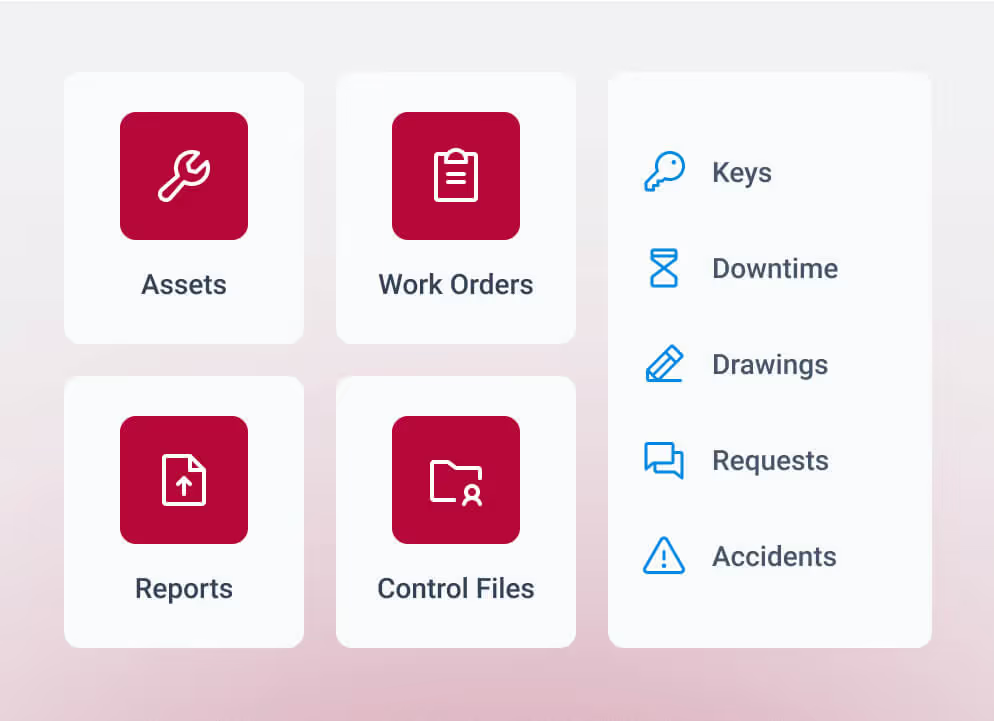Understanding the key differences between ERP and CMMS
Understanding the key differences between ERP and CMMS
In this post

1
2
3
Understanding the key differences between ERP and CMMS
ERP systems manage financial and business processes, while CMMS software focuses on asset maintenance and reliability. MEX CMMS bridges this gap by integrating with ERP systems to streamline maintenance workflows, asset tracking, and operational reporting.
For a number of years now, Excel spreadsheets have formed the core of many maintenance operations. With the dominance of Microsoft in the workplace. Most companies would already have Windows based computers set up in all their offices. More often than not, these computers also come with the Microsoft Office suit installed. With Excel easily accessible and having so many users already familiar with the program, many companies choose to record their maintenance tasks in Excel Spreadsheets. With that, users tend to pick up the data entry process more easily, resulting in less money spent on training users. This also cuts out the need to purchase a specific system, as excel is seen to be doing the job, and some might claim that it does so successfully.
But in the ever evolving IT world, and with the introduction of comprehensive maintenance management software. There are more efficient means of managing a maintenance operation emerging. Yes it may cost you a lot more than just having the Excel system. But the software can save you hundreds of hours of data entry and manipulation. It will provide an easy to use platform that will allow you to store thousands of assets and search data sets in the blink of an eye. Giving users the ability to enter record after record of work performed and allow for upcoming preventative maintenance templates to be set up and pushed out according to a defined maintenance frequency.
Although an excel spreadsheet can be convenient, the advantages of implementing a maintenance software clearly outweigh that of the simple spreadsheet. To put it in perspective, here are some scenarios of maintenance tasks you might be having trouble with in excel, compared to how a maintenance software can handle the task.
Adding records
Records are entered line by line, just finding the correct line to enter information can be a time consuming task in itself. With a maintenance system you get a structured Asset Register and all current work, history, readings and costs associated with each respective piece of equipment. Making data entry a simple process. To go one step further, data imports can be set up to allow for hundreds of records to be imported into the system in no time.
Scheduling work to be done
Using excel, a user will have to go through several pages of information, create a number of specific sheets and spend time deciding which resource to assign to what job. With a maintenance system, you get to set up your users into their respective roles. For example Electricians, Fitters, Mechanics etc… All work can also be set up with estimated work completion times. With the click of a button, schedules can be created from your work selection, assigning the appropriate trades and providing all the information they need to carry out the job.
Printing Reports
Unless you know what you are looking for, you will need to spend the time creating specific graphs and reports on separate spreadsheets. Every time one is requested. Statutory Reporting is now standard in most systems, making it easy for users to provide a range of reports on Assets, Maintenance Costs and Work history upon request.
Managing Maintenance Requests
With the current system, if a non-critical asset breaks down in the middle of the night you will most likely receive a phone call at 2 in the morning requesting maintenance help. But with a request system in place, users can log requests online, allowing for the request to be filtered and the appropriate staff and required action assigned to the task.
Accessing The Maintenance System
You will most likely be restricted to accessing your excel spreadsheet from the computer it is saved from. Or through the network of computers that have been given access to the excel files. Today's Maintenance Software systems can be set up to allow access from almost anywhere. Access when the network is nonexistent, from an iPhone, Tablet or even remotely from outside your network.
Disaster recovery plan
As most spreadsheets are either locally stored on a computer or on the local network. Backing up and restoring the file can be complicated. There are some cases when the files are not even backed up at all. Having an up to date maintenance system will come with it, a foolproof backup procedure that's easy to configure. This plan will ensure that your data is backed up and available for restoration, should there be a crash in the system or a disaster.
Having in place a comprehensive maintenance software will not only help you grow your business, but will amount to a mountain of savings in maintenance costs. The number of equipment breakdowns will be on the decline and you'll find that your maintenance staff spend less time doing data entry and management, but more time effectively maintaining your equipment. Think about it, with your current excel based system, are any of the above achievable?
If you would like to try the MEX Maintenance Software, click the following link: Trial MEX Online
- While ERP software manages finance and planning, a CMMS like MEX focuses on maintenance operations, asset reliability, and uptime.
- From asset tracking to preventive maintenance scheduling, achieve visibility and control beyond what traditional ERP systems can offer.
- Integrate with ERP systems to synchronise asset data, automate maintenance workflows, and streamline reporting across the entire organisation.

Download your whitepaper now
You’re all set!
Your eBook is on its way to your inbox. We hope it brings fresh insights and practical takeaways to help you get more from your maintenance operations.


Understanding the key differences between ERP and CMMS

For a number of years now, Excel spreadsheets have formed the core of many maintenance operations. With the dominance of Microsoft in the workplace. Most companies would already have Windows based computers set up in all their offices. More often than not, these computers also come with the Microsoft Office suit installed. With Excel easily accessible and having so many users already familiar with the program, many companies choose to record their maintenance tasks in Excel Spreadsheets. With that, users tend to pick up the data entry process more easily, resulting in less money spent on training users. This also cuts out the need to purchase a specific system, as excel is seen to be doing the job, and some might claim that it does so successfully.
But in the ever evolving IT world, and with the introduction of comprehensive maintenance management software. There are more efficient means of managing a maintenance operation emerging. Yes it may cost you a lot more than just having the Excel system. But the software can save you hundreds of hours of data entry and manipulation. It will provide an easy to use platform that will allow you to store thousands of assets and search data sets in the blink of an eye. Giving users the ability to enter record after record of work performed and allow for upcoming preventative maintenance templates to be set up and pushed out according to a defined maintenance frequency.
Although an excel spreadsheet can be convenient, the advantages of implementing a maintenance software clearly outweigh that of the simple spreadsheet. To put it in perspective, here are some scenarios of maintenance tasks you might be having trouble with in excel, compared to how a maintenance software can handle the task.
Adding records
Records are entered line by line, just finding the correct line to enter information can be a time consuming task in itself. With a maintenance system you get a structured Asset Register and all current work, history, readings and costs associated with each respective piece of equipment. Making data entry a simple process. To go one step further, data imports can be set up to allow for hundreds of records to be imported into the system in no time.
Scheduling work to be done
Using excel, a user will have to go through several pages of information, create a number of specific sheets and spend time deciding which resource to assign to what job. With a maintenance system, you get to set up your users into their respective roles. For example Electricians, Fitters, Mechanics etc… All work can also be set up with estimated work completion times. With the click of a button, schedules can be created from your work selection, assigning the appropriate trades and providing all the information they need to carry out the job.
Printing Reports
Unless you know what you are looking for, you will need to spend the time creating specific graphs and reports on separate spreadsheets. Every time one is requested. Statutory Reporting is now standard in most systems, making it easy for users to provide a range of reports on Assets, Maintenance Costs and Work history upon request.
Managing Maintenance Requests
With the current system, if a non-critical asset breaks down in the middle of the night you will most likely receive a phone call at 2 in the morning requesting maintenance help. But with a request system in place, users can log requests online, allowing for the request to be filtered and the appropriate staff and required action assigned to the task.
Accessing The Maintenance System
You will most likely be restricted to accessing your excel spreadsheet from the computer it is saved from. Or through the network of computers that have been given access to the excel files. Today's Maintenance Software systems can be set up to allow access from almost anywhere. Access when the network is nonexistent, from an iPhone, Tablet or even remotely from outside your network.
Disaster recovery plan
As most spreadsheets are either locally stored on a computer or on the local network. Backing up and restoring the file can be complicated. There are some cases when the files are not even backed up at all. Having an up to date maintenance system will come with it, a foolproof backup procedure that's easy to configure. This plan will ensure that your data is backed up and available for restoration, should there be a crash in the system or a disaster.
Having in place a comprehensive maintenance software will not only help you grow your business, but will amount to a mountain of savings in maintenance costs. The number of equipment breakdowns will be on the decline and you'll find that your maintenance staff spend less time doing data entry and management, but more time effectively maintaining your equipment. Think about it, with your current excel based system, are any of the above achievable?
If you would like to try the MEX Maintenance Software, click the following link: Trial MEX Online


Related resources
You’ve seen what’s possible—connect with us to learn how TMA Systems can support your goals beyond the event.
You’ve read the insights, now see how TMA Systems helps teams put them into practice.
From ideas to impact
You’ve read the insights, now see how TMA Systems helps teams put them into practice.
From screen to solution
You’ve watched what’s possible, now see how TMA Systems works for your organization.
From insight to implementation
You’ve explored the strategies, now see how we can bring them to life across your real facilities.





